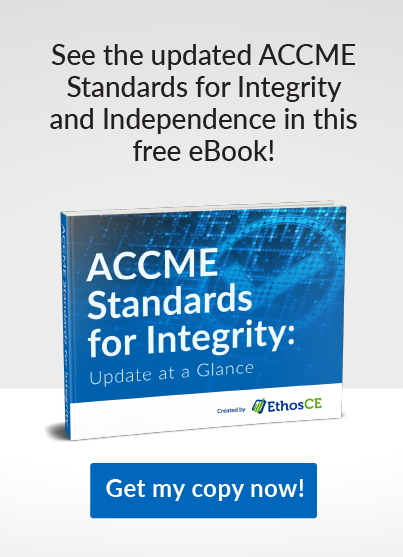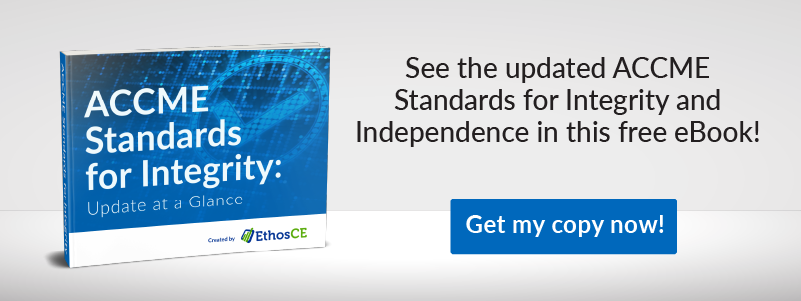New Standards around Funding in Continuing Medical Education
The potential for bias in continuing medical education (CME) isn’t a new one. This issue comes up for debate regularly because more often than not, it involves pharmaceutical, medical device, and other ineligible companies that may participate within the workings of CME. This ranges from educational events like conferences and virtual events, as well as with the providers themselves.
Providers take on significant risks when preparing for a CME event. On the one hand, if they accept funding in continuing medical education, then they can offer low-cost or no-cost activities to their learners. On the other hand, if they remove commercial influence, this will likely involve higher costs for events.
How ineligible companies work with providers has changed, and the ACCME has put forth guidelines to address this. When it comes down to the new Standards, the issues surrounding funding in continuing medical education must be addressed. As a CME provider, you must ensure that your decisions are free of the control of commercial interest or that you have processes in place to deal with commercial funding.
Here, we discuss the Standards for Integrity and Independence in Continuing Education as they apply to your funding in continuing medical education.
Keeping Valid Content—without Funding—on the Straight and Narrow
Funding in continuing medical education has no place where healthcare professionals meet to discuss, debate, and explore new and evolving topics. As a provider, you know that these areas need to be clearly identified as such within your program and that individual presentations should be able to take place without ineligible company commercial bias of any form. It’s up to you to make sure your content is always fair and balanced and supports everything dealing with safe, effective patient care.
According to Standard 1, when it comes to planners, faculty, presenters, and authors, you can’t allow any commercial interests to control or influence your CME programs. Otherwise, the content could be skewed to the side of the drug and medical device companies or other ineligible companies that may become involved in educational activities.
Bias and Funding in Continuing Medical Education Detracts from Learning
The purpose of CME is for your learners to concentrate on obtaining their ongoing education credits for their licenses and hospital privileges. They should not be exposed to commercial bias or marketing from an ineligible company at any point during that education.
Standard 2 states that it’s up to you to ensure that all decisions related to your planning, faculty selection, delivery, and evaluation of accredited education are made without any influence or involvement from the owners and employees of an ineligible company. None of these individuals can actively promote or sell their products or services that serve their professional or financial interests during accredited education.
That said, if you do want to share your learners’ names or contact information with an ineligible company because that company is a sponsor of your activity or event, for example, you have to obtain the learners’ explicit consent. If they want to opt out yet still register for your activities, they can do just that without being presented with a long list of terms and conditions.
Change Your Funding Processes: Identify, Mitigate, and Disclose Relevant Financial Relationships about Ineligible Companies
Suppose that you’re in the process of planning your activities. As you know from Standard 3, you’re responsible for identifying relevant financial relationships between individuals in control of educational content and those associated with ineligible companies. How does identifying, mitigating, and disclosing relevant financial relationships work when dealing with funding in continuing medical education? Let’s get a snapshot view of the many steps.
- Ensure that you collect the information from every ineligible company’s planners, faculty, speakers, and others in control of your content. These details have to be from the past twenty-four months before their involvement in your accredited CME activity.
- Be sure that individuals disclose all financial information, regardless of the amount.
- Review the information that you’ve collected to determine which relationships are relevant, which is the case if your content and the individual who controls it are related to the business lines or products of an ineligible company.
- Mitigate this relevant relationship because it’s related to that person’s role.
- Ensure that your learners receive the names of the individuals who have relevant relationships with your content, their company names, and the nature of those relationships.
- Provide your learners with a statement that the relationships have been mitigated.
- Document the steps taken to mitigate relevant financial relationships.
- Disclose information in a format that can be verified at the time of accreditation, before beginning the accredited education.
Managing Your Commercial Support the Easy Way
According to Standard 4, if you choose to accept commercial funding that’s defined as financial or in-kind support from ineligible companies, there are guidelines to follow. You’re responsible for ensuring that the funding in continuing medical education remains independent of the funding company and that the support does not result in commercial bias or commercial influence in the education. What can you do or not do?
- Keep meticulous records of the funding support dollar amounts and how they were used.
- Funding companies can’t pay directly for any expenses of the education or the learners.
- You can use the funding that you receive to fund honoraria or travel expenses of planners, faculty, presenters, and others in control of the content.
- You can use the funding to defray or eliminate the cost of all learners’ education.
- Document and document even more. Ensure that your agreement with the funding company covers all terms, conditions, amounts, and purposes between you and the funding company.
- As the accredited provider, you must produce that accounting when it’s requested by the accrediting body or the ineligible company funding the activity.
- Disclose to your learners the company name(s) that are providing the support if it was in-kind; however, don’t disclose any corporate or product logos, trade names, or product group messages.
Put Ancillary Activities Where They Belong: Make Them Distinguishable
As per Standard 5, your learners must be able to easily distinguish between your accredited activities and other activities from the ineligible company providing the funding. This includes any marketing or advertising for all your activities, whether they’re virtual or live. In addition to this, you must establish a thirty-minute window between your accredited activities and any other activities and make sure that the non-accredited activities are clearly labeled so there’s no hint of a sponsor’s messaging.
When it comes to your print, online, or digital activities, learners should only engage with the education, not with the funding company’s product promotions or advertisements.
Funding in Today’s CME
In today’s CME, dealing with funding from ineligible companies can be challenging. However, following the ACCME’s guidelines will help ensure that your many accredited education decisions are free of the control of those companies that may want to inject their own commercial interests into your activities.
At EthosCE, we understand the challenges of staying up to date and compliant with ACCME changes. We know how critical it is to get things done right the first time when it comes to team-based education and success.
To learn how EthosCE can enhance the continuing education of your healthcare teams, schedule a free 1-on-1 demo with one of our specialists today!
 We're now part of the Cadmium product suite! Learn more
We're now part of the Cadmium product suite! Learn more 


